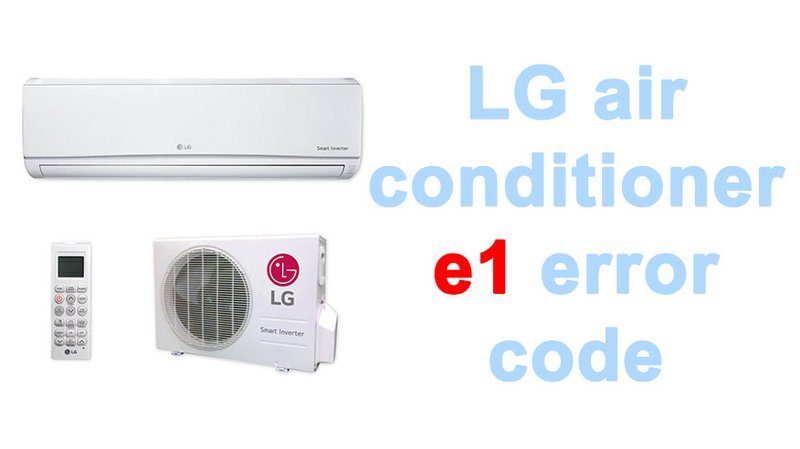
When your LG air conditioner flashes the E1 error code, it’s like a distress signal, indicating that something isn’t quite right. This code can pop up for various reasons, ranging from sensor malfunctions to more complex issues within the device. It’s a lot like when your car’s check engine light comes on — sometimes it’s an easy fix, and other times it requires a bit more elbow grease. Fortunately, you don’t need to be an HVAC expert to try out some first-aid techniques. A reset might just be the simplest thing to try first.
Understanding the E1 Error Code
The E1 error code is a common issue LG air conditioner users face. It’s essentially your unit’s way of communicating that there’s a problem that needs attention. Think of it as the air conditioner throwing up a metaphorical “Help me” flag. Most often, the E1 error code is linked to a fault in the unit’s temperature sensor, which is crucial for maintaining the desired coolness in your space. Imagine trying to bake a cake without knowing the oven’s temperature — that’s how your air conditioner feels without a properly working sensor.
Now, you might ask, “Why does this happen?” Well, several factors could be at play here. It could be due to a loose wire or connection issues within the sensor itself. Just like a loose plug can stop your favorite lamp from lighting up, a loose connection can prevent your AC’s sensor from working correctly. In some cases, it could also be the result of dust buildup or even electrical interference. It’s important to remember that while the E1 error may seem daunting, it doesn’t always mean a major component failure.
A misreading from the sensor can lead the system to shut down or work inefficiently, but don’t worry — there’s a silver lining. In many cases, simply resetting the system could clear the error if it’s caused by a temporary glitch. However, if the code persists, further investigation is warranted to prevent any long-term damage.
How to Reset Your LG Air Conditioner
Resetting your LG air conditioner is akin to rebooting your computer when it’s acting up — it’s often the quickest and easiest solution to many technical problems. To begin, you should first power off the unit using the remote or the power button on the unit itself. This step allows the system to come to a complete stop, which is crucial for a proper reset.
Next, it’s time to unplug the air conditioner from the power source. If it’s a window unit, simply pulling the plug from the outlet will suffice. For central air systems, you might need to locate the circuit breaker and flip it off. Leave it unplugged or off for a few minutes to ensure all the internal circuits reset properly.
Afterward, plug it back in or switch the circuit breaker back on, and then power up the air conditioner again. At this point, you should observe whether the E1 code disappears. If the error is still there, it means that the issue might be more than just a temporary glitch. But don’t lose hope — there are more steps you can take!
What to Do If Resetting Doesn’t Work
If resetting doesn’t do the trick, don’t worry. There are still strategies to tackle the E1 error. The next step would be to check the wiring and connections related to the temperature sensor. Just like a loose button can make your TV remote unresponsive, a loose wire can prevent the sensor from functioning properly. Carefully inspect for any visible disconnections or damaged wires.
If everything seems intact, consider cleaning any dust or debris around the sensor and other internal components. Clogged dust can lead to overheating and sensor malfunction, much like how a clogged air filter hinders a car’s performance. Using a small vacuum or a soft brush can help remove dust that might be affecting the air conditioner’s performance.
In situations where DIY steps don’t resolve the error, it might be time to call in the professionals. An expert can perform a thorough examination and repair any faults you might have missed. They can also recalibrate or replace the sensor if necessary, ensuring your air conditioner returns to optimal functionality.
Preventive Measures to Avoid Future Errors
To keep your air conditioner running smoothly and minimize the risk of encountering the E1 error again, a little preventive maintenance goes a long way. Regularly cleaning the filter and ensuring there’s no obstruction around the unit can make a significant difference. Think of it as regularly checking and rotating your car’s tires to ensure they wear evenly.
Schedule routine maintenance checks with an HVAC technician to assess and service your unit. Much like a yearly doctor check-up keeps you healthy, these assessments help catch any potential issues early on before they become serious problems.
Finally, always ensure that the air conditioner is installed correctly and that it’s getting the correct voltage from the power supply. It’s akin to ensuring your phone charger matches your device to prevent charging issues. Keeping these elements in check can help extend the lifespan of your air conditioner and keep it functioning efficiently.
In summary, while resetting your LG air conditioner may solve the E1 error, it’s essential to understand the problem thoroughly and consider additional steps if needed. Proper maintenance and timely professional help can keep your air conditioner running at its best, ensuring you remain cool and comfortable all year round.